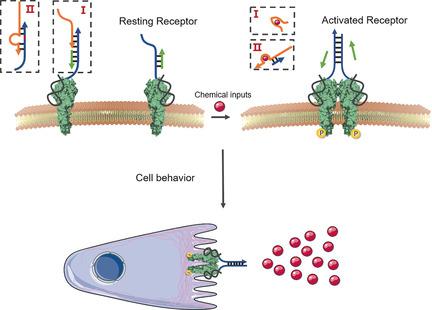当前位置:
X-MOL 学术
›
Angew. Chem. Int. Ed.
›
论文详情
Our official English website, www.x-mol.net, welcomes your
feedback! (Note: you will need to create a separate account there.)
A DNA‐Mediated Chemically Induced Dimerization (D‐CID) Nanodevice for Nongenetic Receptor Engineering To Control Cell Behavior
Angewandte Chemie International Edition ( IF 16.1 ) Pub Date : 2018-07-15 , DOI: 10.1002/anie.201806155 Hao Li 1 , Miao Wang 1 , Tianhui Shi 1 , Sihui Yang 1 , Jinghui Zhang 1 , Hong-Hui Wang 1 , Zhou Nie 1
Angewandte Chemie International Edition ( IF 16.1 ) Pub Date : 2018-07-15 , DOI: 10.1002/anie.201806155 Hao Li 1 , Miao Wang 1 , Tianhui Shi 1 , Sihui Yang 1 , Jinghui Zhang 1 , Hong-Hui Wang 1 , Zhou Nie 1
Affiliation

|
Small‐molecule regulation is a powerful switching tool to manipulate cell signal transduction for a desired function; however, most available methods usually require genetic engineering to endow cells with responsiveness to user‐defined small molecules. Herein, we demonstrate a nongenetic approach for small‐molecule‐controlled receptor activation and consequent cell behavior manipulation that is based on DNA‐mediated chemically induced dimerization (D‐CID). D‐CID uses a programmable chemical‐responsive DNA nanodevice to trigger DNA strand displacement and induce the activation of c‐Met, a tyrosine kinase receptor cognate for hepatocyte growth factor, through dimerization. Through the use of various functional nucleic acids, including aptamers and DNAzymes, as recognition modules, the versatility of D‐CID in inducing c‐Met signaling upon addition of various small‐molecular or ionic cues, including ATP, histidine, and Zn2+, is demonstrated. Moreover, owing its multi‐input properties, D‐CID can be used to manipulate the behaviors of multiple cell populations simultaneously in a selective and programmable fashion.
中文翻译:

DNA介导的化学诱导二聚化(D-CID)纳米装置用于非遗传受体工程来控制细胞行为
小分子调节是一种功能强大的切换工具,可操纵细胞信号转导以实现所需功能。但是,大多数可用方法通常需要基因工程来赋予细胞对用户定义的小分子的响应能力。本文中,我们展示了一种非遗传方法,用于基于DNA介导的化学诱导的二聚化(D-CID)的小分子控制的受体激活和随后的细胞行为操纵。D‐CID使用可编程的化学响应性DNA纳米装置触发DNA链移位并通过二聚作用诱导c-Met的活化,c-Met是与肝细胞生长因子同源的酪氨酸激酶受体。通过使用各种功能核酸(包括适体和DNA酶)作为识别模块,2+,演示。此外,由于其多输入特性,D-CID可用于以选择性和可编程的方式同时操纵多个细胞群体的行为。
更新日期:2018-07-15
中文翻译:

DNA介导的化学诱导二聚化(D-CID)纳米装置用于非遗传受体工程来控制细胞行为
小分子调节是一种功能强大的切换工具,可操纵细胞信号转导以实现所需功能。但是,大多数可用方法通常需要基因工程来赋予细胞对用户定义的小分子的响应能力。本文中,我们展示了一种非遗传方法,用于基于DNA介导的化学诱导的二聚化(D-CID)的小分子控制的受体激活和随后的细胞行为操纵。D‐CID使用可编程的化学响应性DNA纳米装置触发DNA链移位并通过二聚作用诱导c-Met的活化,c-Met是与肝细胞生长因子同源的酪氨酸激酶受体。通过使用各种功能核酸(包括适体和DNA酶)作为识别模块,2+,演示。此外,由于其多输入特性,D-CID可用于以选择性和可编程的方式同时操纵多个细胞群体的行为。









































 京公网安备 11010802027423号
京公网安备 11010802027423号